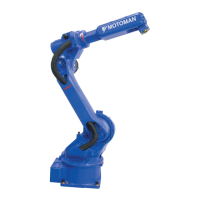6-10
168542-1CD
168542-1CD
MLX200 Software and
Operations
6 Conveyor Tracking
6.6 Conveyor Tracking Setup Procedure
6.6 Conveyor Tracking Setup Procedure
6.6.1 Verify Counter Card is Functional
Before attempting Conveyor Tracking operations, the functionality of the
counter card (or comparable device) should be verified. To do this, first
temporarily unschedule the MLX_Conveyor_0 Task so that MLX200 is not
interacting with the conveyor setup. Verify the following steps:
1. Turn conveyor on and start moving it. The Conveyor0_CurrentValue
should start increasing.
2. Place an object on the conveyor and have it move past the photo eye.
As it crosses, the Conveyor0_CurrentValue should be stored in the
Conveyor0_LatchedValue tag, and the Conveyor0_NewData bit
should turn to 1.
3. In this state, place another object on the conveyor and move it past the
photo eye. This time the Conveyor0_LatchedValue tag should not
change (as there is already a latched value).
4. Toggle the Conveyor0_ResetNewData bit. The Conveyor0_NewData
bit should turn to 0.
5. Place another object on the conveyor and move it past the photo eye.
The behavior now (after the data flag is reset) should be the same as
in step 2.
If the above steps work correctly, the hardware is configured properly. If
not, it is important to debug the counter card before moving on to the next
step.
6.6.2 Calculate Conveyor Resolution
With the conveyor stopped, set a part on a conveyor. Place a ruler next to
the conveyor. Record the Conveyor0_CurrentValue for the current
position. Operate the conveyor to move the part approximately 1000 mm.
Measure the distance that the part traveled (mm). Record the new
Conveyor0_CurrentValue, and subtract the previous value to determine
the change in encoder pulse counts. Calculate the pulse count conversion
factor (distance traveled / pulse counts), and enter the value in
ApplicationData.ConveyorData[].EncoderToMMConversion tag.
To verify the tag is correct, operate the conveyor again and verify that the
changing ApplicationData.ConveyorData [].ConveyorPosition variable is
reporting the distance traveled in mm.
6.6.3 Teach a User Frame
Install a pointing device on the robot and enter the tool data. Teach a user
frame for the conveyor. The direction of travel for the conveyor should be
the +X direction of the conveyor frame. Record this frame number in the
ApplicationData.UserFrame[].UserFrameNumber tag and add a call to
MLxRobotSetUserFrame in your application logic.
If the behavior of the Conveyor Tracking tags does not match what is
described below, Conveyor Tracking operations will not work correctly
and could cause unexpected robot behavior.

